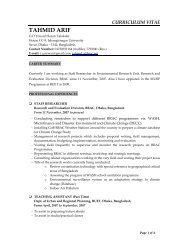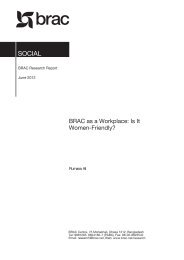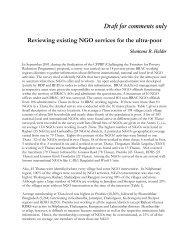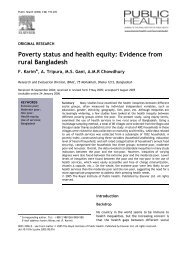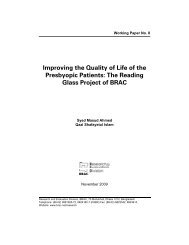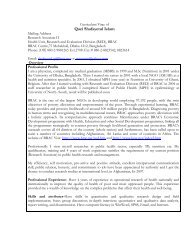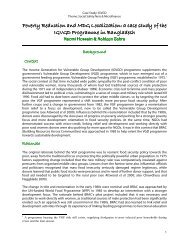Combining health and social protection measures to reach the ultra ...
Combining health and social protection measures to reach the ultra ...
Combining health and social protection measures to reach the ultra ...
You also want an ePaper? Increase the reach of your titles
YUMPU automatically turns print PDFs into web optimized ePapers that Google loves.
Introduction<br />
Type I<br />
Type II<br />
Type III<br />
Prevalent in both rich <strong>and</strong> poor countries, with large<br />
numbers of vulnerable population in each.<br />
Prevalent in both rich <strong>and</strong> poor countries, but with a<br />
substantial proportion of <strong>the</strong> cases in poor countries.<br />
Overwhelmingly or exclusively prevalent in<br />
developing countries.<br />
Box 1: Categories of diseases according <strong>to</strong> <strong>the</strong>ir relative<br />
prevalence in higher- <strong>and</strong> lower-income countries<br />
The role of <strong>health</strong> systems 7 in challenging inequity has<br />
been <strong>the</strong> subject of study by <strong>the</strong> CSDH Knowledge Network<br />
on Health Systems. The report of this Knowledge Network 8<br />
syn<strong>the</strong>sises a large amount of available evidence on how<br />
<strong>health</strong> systems can contribute <strong>to</strong> reducing <strong>health</strong> inequities<br />
<strong>and</strong> provides a policy guide on actions that can be taken <strong>to</strong><br />
address <strong>the</strong>se inequities, including mobilizing intersec<strong>to</strong>ral<br />
relationships, facilitating <strong>social</strong> empowerment, building up<br />
universal coverage, revitalizing primary <strong>health</strong> care,<br />
streng<strong>the</strong>ning <strong>the</strong> process of developing <strong>and</strong> implementing<br />
policies, <strong>and</strong> securing international support for nationally-led<br />
<strong>health</strong> system transformation <strong>and</strong> action. While <strong>the</strong> focus of<br />
<strong>the</strong> report is on <strong>the</strong> use of existing knowledge, it identifies<br />
many gaps <strong>and</strong> also serves as a stepping off point for an<br />
extensive agenda of new research. This is especially<br />
important in <strong>the</strong> light of <strong>the</strong> fact that, as <strong>the</strong> report itself notes,<br />
<strong>the</strong> experience of <strong>health</strong> systems is always context-specific.<br />
Innovation<br />
Research <strong>to</strong> improve <strong>health</strong> is best unders<strong>to</strong>od as a process<br />
within a chain of <strong>health</strong> innovation that begins with a<br />
concept, question or observation <strong>and</strong> proceeds through<br />
experimental investigation <strong>to</strong>wards <strong>the</strong> eventual application of<br />
<strong>the</strong> results <strong>to</strong> <strong>the</strong> use of a new process or product in <strong>the</strong> field.<br />
Innovation for <strong>health</strong> equity should not be regarded as being<br />
restricted <strong>to</strong> <strong>the</strong> creation of affordable <strong>and</strong> appropriate<br />
medical products <strong>and</strong> technologies 9 . It also includes<br />
developing <strong>and</strong> applying underst<strong>and</strong>ing of how <strong>to</strong> improve<br />
equitable access through novel <strong>health</strong> policies, services <strong>and</strong><br />
systems, interventions <strong>and</strong> support mechanisms; <strong>and</strong><br />
encompasses <strong>the</strong> application of <strong>health</strong> technology<br />
assessment <strong>to</strong> assist in selecting <strong>the</strong> most appropriated <strong>and</strong><br />
cost-effective technologies <strong>to</strong> meet <strong>health</strong> needs, especially of<br />
<strong>the</strong> poor <strong>and</strong> vulnerable. And it includes innovations in<br />
underst<strong>and</strong>ings <strong>and</strong> measurements of <strong>health</strong> <strong>and</strong> <strong>health</strong><br />
equity.<br />
Pharmaceutical products for diseases<br />
endemic in developing countries<br />
Diseases have been categorized in<strong>to</strong> Types I <strong>to</strong> III according<br />
<strong>to</strong> <strong>the</strong>ir relative prevalence in higher- <strong>and</strong> lower-income<br />
countries 10 (Box 1).<br />
For a range of diseases that substantially or predominantly<br />
occur in poorer countries (Types II <strong>and</strong> III), access <strong>to</strong><br />
pharmaceutical products for prevention, diagnosis <strong>and</strong><br />
treatment has often been very poor. Two major elements of<br />
this limited access can be identified:<br />
1.For many of <strong>the</strong> diseases which have little or no prevalence<br />
in high-income countries, <strong>the</strong>re has been a dearth of<br />
research <strong>and</strong> development (R&D) resulting in <strong>the</strong><br />
registration of new products. Thus, of <strong>the</strong> new<br />
pharmaceutical products registered for human use in <strong>the</strong><br />
period 1975–1997, only 13 (around 1%) were for tropical<br />
parasitic infections 11 . As a result, treatments are ei<strong>the</strong>r not<br />
available or depend on very old generic drugs that may<br />
have significant side effects <strong>and</strong> efficacies that are limited<br />
<strong>and</strong> declining due <strong>to</strong> emerging resistance. Where<br />
diagnostic <strong>to</strong>ols for <strong>the</strong>se diseases exist, <strong>the</strong>y may be slow,<br />
insensitive or unsuited <strong>to</strong> field conditions prevailing in <strong>the</strong><br />
disease-endemic countries, requiring highly skilled<br />
personnel or sophisticated labora<strong>to</strong>ry settings.<br />
2.In cases where newer <strong>and</strong> more effective drugs, vaccines<br />
<strong>and</strong> diagnostics are available, <strong>the</strong>se have sometimes found<br />
relatively low levels of uptake <strong>and</strong> use in developing<br />
countries, due <strong>to</strong> fac<strong>to</strong>rs including affordability <strong>and</strong> <strong>the</strong><br />
availability of <strong>health</strong> systems for <strong>the</strong>ir delivery.<br />
It is clear that, <strong>to</strong> a large extent, <strong>the</strong>se two elements are<br />
related <strong>to</strong> a common problem – that of market failure.<br />
Substantial R&D investments are needed <strong>to</strong> create new<br />
pharmaceutical products <strong>and</strong> <strong>the</strong>se are unlikely <strong>to</strong> be made<br />
by <strong>the</strong> private sec<strong>to</strong>r where <strong>the</strong>re is not seen <strong>to</strong> be a good<br />
market for recouping <strong>the</strong> investments. Drugs created for a<br />
market in high-income countries, where per capita<br />
expenditures on <strong>health</strong> run in<strong>to</strong> thous<strong>and</strong>s of dollars per year,<br />
may prove <strong>to</strong>o expensive for use in low-income countries<br />
whose <strong>health</strong> expenditures are far less than 100 dollars per<br />
capita per year.<br />
Several different approaches have been explored or<br />
proposed <strong>to</strong> solve <strong>the</strong> problem, varying according <strong>to</strong> <strong>the</strong> stage<br />
in <strong>the</strong> chain of innovation <strong>and</strong> product delivery/uptake at<br />
which <strong>the</strong> market failure is perceived <strong>to</strong> be occurring:<br />
✜ For a range of “neglected diseases” – especially tropical<br />
parasitic infections, but also HIV/AIDS <strong>and</strong> TB –<br />
investments in R&D for drugs, vaccines <strong>and</strong> diagnostics<br />
has come from <strong>the</strong> philanthropic sec<strong>to</strong>r, with <strong>the</strong><br />
Rockefeller Foundation taking a lead in <strong>the</strong> mid 1990s in<br />
<strong>the</strong> creation of product development public-private<br />
partnerships (PDPs) beginning with <strong>the</strong> International<br />
AIDS Vaccine Initiative. The Bill & Melinda Gates<br />
Foundation has made substantial contributions since<br />
2000. More recently, a number of bilateral donors (e.g.<br />
Irel<strong>and</strong>, Ne<strong>the</strong>rl<strong>and</strong>s, Norway, UK) have started <strong>to</strong><br />
become increasingly significant supporters of this<br />
approach 12 . PDPs have generally taken a portfolio<br />
approach, creating a pipeline of c<strong>and</strong>idate products in<br />
development, some of which are now in or about <strong>to</strong> enter<br />
clinical trials. Since <strong>the</strong> latter – especially Phase III trials<br />
<strong>to</strong> prove efficacy <strong>and</strong> involving large numbers of patients<br />
in <strong>the</strong> field – are very expensive, a major challenge now<br />
facing <strong>the</strong> world is how <strong>to</strong> provide adequate funding <strong>to</strong><br />
ensure that effective new products <strong>reach</strong> registration <strong>and</strong><br />
enter clinical use in disease-endemic countries. Across<br />
<strong>the</strong> range of diseases <strong>and</strong> products for which support is<br />
014 ✜ Global Forum Update on Research for Health Volume 4




